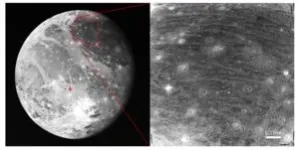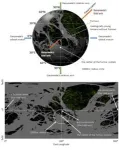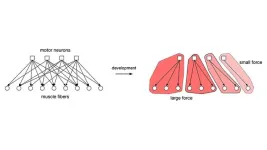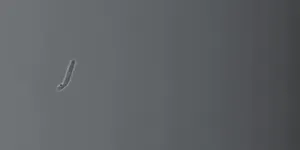(Press-News.org) Around 4 billion years ago, an asteroid hit the Jupiter moon Ganymede. Now, a Kobe University researcher realized that the Solar System's biggest moon's axis has shifted as a result of the impact, which confirmed that the asteroid was around 20 times larger than the one that ended the age of the dinosaurs on Earth, and caused one of the biggest impacts with clear traces in the Solar System.
Ganymede is the largest moon in the Solar System, bigger even than the planet Mercury, and is also interesting for the liquid water oceans beneath its icy surface. Like the Earth’s moon, it is tidally locked, meaning that it always shows the same side to the planet it is orbiting and thus also has a far side. On large parts of its surface, the moon is covered by furrows that form concentric circles around one specific spot, which led researchers in the 1980s to conclude that they are the results of a major impact event. “The Jupiter moons Io, Europa, Ganymede and Callisto all have interesting individual characteristics, but the one that caught my attention was these furrows on Ganymede,” says the Kobe University planetologist HIRATA Naoyuki. He continues, “We know that this feature was created by an asteroid impact about 4 billion years ago, but we were unsure how big this impact was and what effect it had on the moon.”
Data from the remote object is scarce making research very difficult, and so Hirata was the first to realize that the purported location of the impact is almost precisely on the meridian farthest away from Jupiter. Drawing from similarities with an impact event on Pluto that caused the dwarf planet’s rotational axis to shift and that we learned about through the New Horizons space probe, this implied that Ganymede, too, had undergone such a reorientation. Hirata is a specialist in simulating impact events on moons and asteroids, so this realization allowed him to calculate what kind of impact could have caused this reorientation to happen.
In the journal Scientific Reports, the Kobe University researcher now published that the asteroid probably had a diameter of around 300 kilometers, about 20 times as large as the one that hit the Earth 65 million years ago and ended the age of the dinosaurs, and created a transient crater between 1,400 and 1,600 kilometers in diameter. (Transient craters, widely used in lab and computational simulations, are the cavities produced directly after the crater excavation and before material settles in and around the crater.) According to his simulations, only an impact of this size would make it likely that the change in the distribution of mass could cause the moon’s rotational axis to shift into its current position. This result holds true irrespective of where on the surface the impact occurred.
“I want to understand the origin and evolution of Ganymede and other Jupiter moons. The giant impact must have had a significant impact on the early evolution of Ganymede, but the thermal and structural effects of the impact on the interior of Ganymede have not yet been investigated at all. I believe that further research applying the internal evolution of ice moons could be carried out next,” explains Hirata.
Interesting for its subsurface oceans, Ganymede is the final destination of ESA’s JUICE space probe. If everything goes well, the spacecraft will enter orbit around the moon in 2034 and will make observations for six months, sending back a wealth of data that will help answer Hirata’s questions.
This research was funded by the Japan Society for the Promotion of Science (grants 20K14538 and 20H04614) and the Hyogo Science and Technology Association.
Kobe University is a national university with roots dating back to the Kobe Commercial School founded in 1902. It is now one of Japan’s leading comprehensive research universities with nearly 16,000 students and nearly 1,700 faculty in 10 faculties and schools and 15 graduate schools. Combining the social and natural sciences to cultivate leaders with an interdisciplinary perspective, Kobe University creates knowledge and fosters innovation to address society’s challenges.
END
Gigantic asteroid impact shifted the axis of Solar System's biggest moon
2024-09-03
ELSE PRESS RELEASES FROM THIS DATE:
Finger wrap uses sweat to provide health monitoring at your fingertips—literally
2024-09-03
A sweat-powered wearable has the potential to make continuous, personalized health monitoring as effortless as wearing a Band-Aid. Engineers at the University of California San Diego have developed an electronic finger wrap that monitors vital chemical levels—such as glucose, vitamins, and even drugs—present in the same fingertip sweat from which it derives its energy.
The advance was published Sept. 3 in Nature Electronics by the research group of Joseph Wang, a professor in the Aiiso Yufeng Li Family Department of Chemical and Nano Engineering ...
Large sharks may be hunting each other – and scientists know because of a swallowed tracking tag
2024-09-03
Who killed the pregnant porbeagle?
In a marine science version of the game Cluedo, researchers from the US have now accused a larger shark, with its deciduous triangular teeth, in the open sea southwest of Bermuda. This scientific whodunnit is published in Frontiers in Marine Science.
“This is the first documented predation event of a porbeagle shark anywhere in the world,” said lead author Dr Brooke Anderson, a former graduate student at Arizona State University.
“In one event, the population not only lost a reproductive female that could contribute to population growth, but it also lost all her developing ...
Can’t stop belching? Dietary habits or disease could be the reason
2024-09-03
Belching is a common bodily function, but when it escalates to a level that interferes with daily life, it is defined as belching disorders. International surveys have reported that approximately 1% of adults have belching disorders, but the percentage in Japan and the factors involved often elude medical professionals.
To examine the relationship between the rate of belching disorders, comorbidities, and lifestyles in Japan, a research team led by Professor Yasuhiro Fujiwara of Osaka Metropolitan University’s Graduate School of Medicine ...
Exploring peptide clumping for improved drug and material solutions
2024-09-03
Scientists from China have investigated how short peptide chains aggregate together in order to deepen our understanding of the process, which is crucial for drug stability and material development. Their study, published in JACS Au, provides valuable insights into how short proteins called peptides interact, fold, and function. These findings have significant implications for medicine, material science, and biotechnology.
Peptides are short chains of amino acids that play essential roles in the body by building structures, speeding up chemical reactions, and supporting our immune system. The specific function of a protein is determined by how its amino acids interact with each other and ...
Young adults let down by ‘postcode lottery’ for ADHD treatment - national survey
2024-09-03
A national survey conducted as part of University of Exeter research has found huge variation in treatment for ADHD, highlighting the struggle many young adults face once they turn 18.
Researchers have warned that the current system is failing many young adults as they transition from children’s to adult’s services - suddenly finding themselves unable to access treatment because services do not link up effectively.
More than 750 people from across the country – including commissioners, healthcare professionals working ...
False-positive mammography result may discourage women from subsequent screening
2024-09-02
Embargoed for release until 5:00 p.m. ET on Monday 2 September 2024
Annals of Internal Medicine Tip Sheet
@Annalsofim
Below please find summaries of new articles that will be published in the next issue of Annals of Internal Medicine. The summaries are not intended to substitute for the full articles as a source of information. This information is under strict embargo and by taking it into possession, media representatives are committing to the terms of the embargo not only on their own behalf, but also on behalf of the organization they represent.
----------------------------
1. ...
False-positive mammograms discourage some women from future screenings
2024-09-02
Early detection of breast cancer through mammography screening continues to save lives. However, abnormal findings on mammograms can lead to women being recalled for additional imaging and biopsies, many of which turn out to be “false positives,” meaning they do not result in a cancer diagnosis. False positives can also have financial implications for patients and cause significant emotional anxiety.
A major, new study led by the UC Davis Comprehensive Cancer Center has found that women who received a false-positive result that required additional imaging or biopsy were less likely to return ...
The nervous system’s matchmaker
2024-09-02
When you ask a rideshare app to find you a car, the company’s computers get to work. They know you want to reach your destination quickly. They know you’re not the only user who needs a ride. And they know drivers want to minimize idle time by picking up someone nearby. The computer’s job, says Cold Spring Harbor Laboratory Associate Professor Saket Navlakha, is to pair drivers with riders in a way that maximizes everyone’s happiness.
Computer scientists like Navlakha call this bipartite matching. It’s the same task handled by systems pairing organ donors with transplant candidates, medical students with residency ...
Open Wide: Human Mouth Bacteria Reproduce through Rare Form of Cell Division
2024-09-02
By Emily Greenhalgh
One of the most diverse ecosystems on the planet is closer than you think — right inside your mouth. Your mouth is a thriving ecosystem of more than 500 different species of bacteria living in distinct, structured communities called biofilms. Nearly all of these bacteria grow by splitting [or dividing] into two, with one mother cell giving rise to two daughter cells.
New research from the Marine Biological Laboratory (MBL) and ADA Forsyth uncovered an extraordinary mechanism of cell division in Corynebacterium matruchotii, one of the most common bacteria living in dental plaque. ...
KIMM develops wheel that alters stiffness in real time based on situation
2024-09-02
A new technology for wheels and mobile systems, necessary for overcoming various obstacles in daily life such as stairs or rocks by adjusting the stiffness of the wheel in real time, has been developed for the first time in the world. This noble technology is anticipated to find wide applications in various moving vehicles equipped with wheels, where overcoming terrain obstacles is essential.
The Korea Institute of Machinery and Materials (President Seog-Hyeon Ryu, hereinafter referred to as KIMM), an institute under the jurisdiction of the ...









